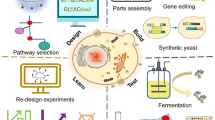Abstract
Protein titers, a key bioprocessing metric, depend both on the synthesis of protein and the degradation of protein. Secreted recombinant protein production in Saccharomyces cerevisiae is an attractive platform as minimal media can be used for cultivation, thus reducing fermentation costs and simplifying downstream purification, compared to other systems that require complex media. As such, engineering S. cerevisiae to improve titers has been then the subject of significant attention, but the majority of previous efforts have been focused on improving protein synthesis. Here, we characterize the protein uptake and degradation pathways of S. cerevisiae to better understand its impact on protein secretion titers. We do find that S. cerevisiae can consume significant (in the range of 1 g/L/day) quantities of whole proteins. Characterizing the physiological state and combining metabolomics and transcriptomics, we identify metabolic and regulatory markers that are consistent with uptake of whole proteins by endocytosis, followed by intracellular degradation and catabolism of substituent amino acids. Uptake and degradation of recombinant protein products may be common in S. cerevisiae protein secretion systems, and the current data should help formulate strategies to mitigate product loss.






Similar content being viewed by others
References
Badawy AAB, Morgan CJ, Turner JA (2008) Application of the Phenomenex EZ:faastTM amino acid analysis kit for rapid gas-chromatographic determination of concentrations of plasma tryptophan and its brain uptake competitors. Amino Acids 34(4):587–596. doi:10.1007/s00726-007-0012-7
Bradford MM (1976) Rapid and sensitive method for quantitation of microgram quantities of protein utilizing principle of protein-dye binding. Anal Biochem 72(1–2):248–254
Bro C, Regenberg B, Forster J, Nielsen J (2006) In silico aided metabolic engineering of Saccharomyces cerevisiae for improved bioethanol production. Metab Eng 8(2):102–111. doi:10.1016/j.ymben.2005.09.007
Canelas AB, ten Pierick A, Ras C, Seifar RM, van Dam JC, van Gulik WM, Heijnen JJ (2009) Quantitative evaluation of intracellular metabolite extraction techniques for yeast metabolomics. Anal Chem 81(17):7379–7389. doi:10.1021/Ac900999t
De Koning W, van Dam K (1992) A method for the determination of changes of glycolytic metabolites in yeast on a subsecond time scale using extraction at neutral pH. Anal Biochem 204(1):118–123
De Nobel JG, Barnett JA (1991) Passage of molecules through yeast cell walls: a brief essay-review. Yeast 7(4):313–323. doi:10.1002/yea.320070402
Hou J, Tyo K, Liu Z, Petranovic D, Nielsen J (2012a) Engineering of vesicle trafficking improves heterologous protein secretion in Saccharomyces cerevisiae. Metab Eng 14(2):120–127. doi:10.1016/j.ymben.2012.01.002
Hou J, Tyo KE, Liu Z, Petranovic D, Nielsen J (2012b) Metabolic engineering of recombinant protein secretion by Saccharomyces cerevisiae. FEMS Yeast Res 12(5):491–510. doi:10.1111/j.1567-1364.2012.00810.x
Huang D, Gore PR, Shusta EV (2008) Increasing yeast secretion of heterologous proteins by regulating expression rates and post-secretory loss. Biotechnol Bioeng 101(6):1264–1275. doi:10.1002/bit.22019
Idiris A, Tohda H, Kumagai H, Takegawa K (2010) Engineering of protein secretion in yeast: strategies and impact on protein production. Appl Microbiol Biotechnol 86(2):403–417. doi:10.1007/s00253-010-2447-0
Kugler F, Graneis S, Schreiter PPY, Stintzing FC, Carle R (2006) Determination of free amino compounds in betalainic fruits and vegetables by gas chromatography with flame ionization and mass spectrometric detection. J Agric Food Chem 54(12):4311–4318. doi:10.1021/Jf060245g
Lu H, Liang Y, Dunn WB, Shen H, Kell DB (2008) Comparative evaluation of software for deconvolution of metabolomics data based on GC-TOF-MS. Trends Anal Chem 27(3):215–227
Oliveira AP, Patil KR, Nielsen J (2008) Architecture of transcriptional regulatory circuits is knitted over the topology of bio-molecular interaction networks. BMC Syst Biol 2(1):17
Patil KR, Nielsen J (2005a) Uncovering transcriptional regulation of metabolism by using metabolic network topology. Proc Natl Acad Sci U S A 102(8):2685–2689
Patil KR, Nielsen J (2005b) Uncovering transcriptional regulation of metabolism by using metabolic network topology. Proc Natl Acad Sci U S A 102(8):2685–2689
Pelham HR (2002) Insights from yeast endosomes. Curr Opin Cell Biol 14(4):454–462
Saeed AI, Bhagabati NK, Braisted JC, Liang W, Sharov V, Howe EA, Li J, Thiagarajan M, White JA, Quackenbush J (2006) TM4 microarray software suite. Methods Enzymol 411:134–193. doi:10.1016/S0076-6879(06)11009-5
Shaw JD, Cummings KB, Huyer G, Michaelis S, Wendland B (2001) Yeast as a model system for studying endocytosis. Exp Cell Res 271(1):1–9. doi:10.1006/excr.2001.5373
Snel L, Damgaard U (1988) Proinsulin heterogeneity in pigs. Horm Metab Res 20(8):476–480. doi:10.1055/s-2007-1010862
Tyo KE, Liu Z, Petranovic D, Nielsen J (2012) Imbalance of heterologous protein folding and disulfide bond formation rates yields runaway oxidative stress. BMC Biol 10:16. doi:10.1186/1741-7007-10-16
Usaite R, Patil KR, Grotkjaer T, Nielsen J, Regenberg B (2006) Global transcriptional and physiological responses of Saccharomyces cerevisiae to ammonium, L-alanine, or L-glutamine limitation. Appl Environ Microbiol 72(9):6194–6203. doi:10.1128/Aem.00548-06
van Dijken JP, Bauer J, Brambilla L, Duboc P, Francois JM, Gancedo C, Giuseppin MLF, Heijnen JJ, Hoare M, Lange HC, Madden EA, Niederberger P, Nielsen J, Parrou JL, Petit T, Porro D, Reuss M, van Riel N, Rizzi M, Steensma HY, Verrips CT, Vindelov J, Pronk JT (2000) An interlaboratory comparison of physiological and genetic properties of four Saccharomyces cerevisiae strains. Enzym Microb Technol 26(9–10):706–714
Weinberg J, Drubin DG (2012) Clathrin-mediated endocytosis in budding yeast. Trends Cell Biol 22(1):1–13. doi:10.1016/j.tcb.2011.09.001
Zhang B, Chang A, Kjeldsen TB, Arvan P (2001) Intracellular retention of newly synthesized insulin in yeast is caused by endoproteolytic processing in the Golgi complex. J Cell Biol 153(6):1187–1198
Acknowledgments
We thank Michael Sherer for assistance with yeast growth and protein assays. We thank NIH Kirschstein NRSA fellowship, The Knut and Alice Wallenberg Foundation, EU Framework VII project SYSINBIO (Grant no. 212766), European Research Council project INSYSBIO (Grant no. 247013), the Novo Nordisk Foundation, and the Chalmers Foundation for funding.
Author information
Authors and Affiliations
Corresponding author
Electronic supplementary material
Below is the link to the electronic supplementary material.
ESM 1
(DOCX 675 kb)
Rights and permissions
About this article
Cite this article
Tyo, K.E.J., Liu, Z., Magnusson, Y. et al. Impact of protein uptake and degradation on recombinant protein secretion in yeast. Appl Microbiol Biotechnol 98, 7149–7159 (2014). https://doi.org/10.1007/s00253-014-5783-7
Received:
Revised:
Accepted:
Published:
Issue Date:
DOI: https://doi.org/10.1007/s00253-014-5783-7




